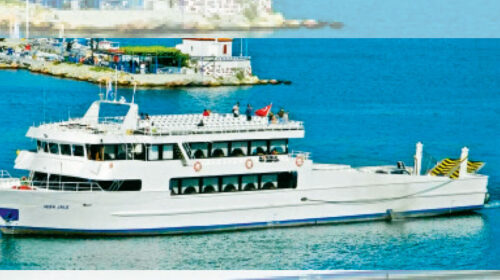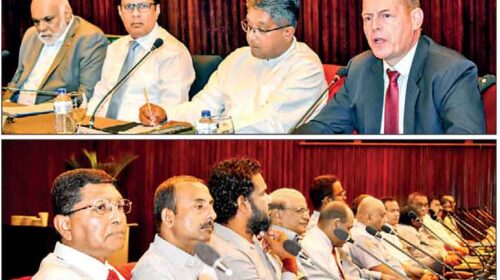Restoring Ferry Service Will Rewrite History of India-Lanka Ties
 The ferry service between India and Sri Lanka, as well as railway connections, have all but vanished since the turn of the 19th and the 20th centuries, and the use of a comfortable Singaporean passenger vessel ‘IndSri‘ to sail between Karikkal (KKL)Port in South India and Kankesanthurai (KKS) Port in Sri Lanka’s Northern Province next month (Mid-May), will rewrite the history of sea connections between Indo-Sri Lanka.
The ferry service between India and Sri Lanka, as well as railway connections, have all but vanished since the turn of the 19th and the 20th centuries, and the use of a comfortable Singaporean passenger vessel ‘IndSri‘ to sail between Karikkal (KKL)Port in South India and Kankesanthurai (KKS) Port in Sri Lanka’s Northern Province next month (Mid-May), will rewrite the history of sea connections between Indo-Sri Lanka.
There was formerly a regular ferry service between India and Sri Lanka that served as an important mode of transportation for both people and cargo. However, with the collapse of the British Raj, severe cyclonic weather, and the civil war in Sri Lanka that began in 1983, the train and boat service was eventually rendered obsolete.
With the intervention of the Governments of India and Sri Lanka, IndSri Ferry Services will begin operations between KKS and Karaikkal (KKL) on 15 May, and the Indian Government has approved says operator Niranjan Nandagopan, MD, Indsri Ferry Services Pvt Ltd. He is a Singaporean who moved there from Jaffna in the early 1980s.
There are four other operators who have approached both governments. They are; Infinity Harbour Services, Mumbai, Drishti Cruise and Ferries Pvt Ltd, Goa, MOH Marine Transport Pvt Ltd, Chennai and KKL Terminal Operators Pvt Ltd, Bangalore. They are also waiting for approvals now.
The IndSri passenger ship will however, transport approximately 150 people between Kankesanthurai (KKS) and Karaikkal (KKL), with daily ferry services from Monday to Saturday departing at 8 a.m. from KKL and arriving at KKS at noon.
On the return journey, the ship will leave KKS at 2 p.m. and arrive at KKL at 6 p.m. with each passenger carrying 100 kg of free baggage allowance.
Ceylon is still the moniker given to Southern Indians, and in the 1970s it was the land of opportunity since the British assisted in the establishment of several tea plantations on the island, which just lacked the labour to run them. So, in the late nineteenth century, British authorities began examining the notion of joining the railway systems of the two colonies in order to facilitate the transportation of people and products between peninsular India and Ceylon.
History of the sea connection
Ajay Kamalakaran writes in 2021 the history of the railway and steamer connections between Indo-Sri Lanka in his article titled: “Boat Mail: Remembering the Train and steamer service from India to Ceylon”. He writes thus:
The first stage was to operate a train between Madras and Tuticorin. Passengers would then board the steamship bound for Colombo. This arduous journey, begun in the late 1800s, would take nearly two days, since the 709-km train ride lasted 21 hours and 50 minutes, while the ship linking the two ports would take somewhere between 21 and 24 hours.
To connect India and Ceylon, the British decided to construct a bridge over the Palk Strait in the 1870s. The plan was to connect peninsular India, Pamban (Rameshwaram) Island, Mannar Island, and the remainder of Ceylon with a series of bridges over the Adam’s Bridge or Rama Setu, establishing a continuous railway link between Colombo and India.
The longest bridge in this chain, according to a research report by Delphine Prema Dhanaseeli, would have been roughly 24 km long and would have connected Thalaimannar at the edge of Ceylon’s Mannar Island to Dhanushkodi at the tip of Pamban Island. The British Raj largely rejected the project but gave Rs 70 lakhs to build the Pamban Bridge, which would link Rameshwaram on the mainland with Mandapam.
The bridge’s construction began in 1902 and was planned by renowned American engineer William Scherzer, who is best known for developing the rolling lift bridge. For the bridge, which needed 2,000 tonnes of steel, manufactured materials were brought from England. The 65.23-metre-long rolling-type lift span, which can open up when vessels pass, was designed and built by Scherzer because engineers wanted to have a rail link without interrupting the ferry service, according to Dhanaseeli.
Natural disasters like cyclones and cholera epidemics played down construction. In 1913, the 2,065-metre-long bridge was completed. The bridge was opened on 24 February 1914. It was the first sea bridge in India and the longest until Mumbai’s Bandra-Worli Sea Link was erected in the 21st century.
The inauguration is believed to have been grand for the British Empire, with the foreign press invited to a ceremony presided over by John Sinclair, Governor of Madras, and Robert Chalmers, Governor of Ceylon, as well as Neville Priestley, MD, South Indian Railways. The railway and steamer service between the two countries, known as the Indo-Ceylon Express, was widely publicised on a global scale. It was known as the ‘Boat Mail’ service.
From Egmore, the Boat Mail would travel to the Dhanushkodi Port. As soon as the passengers exited the train, immigration procedures were followed. Passengers from India and Ceylon would receive passports for the steamer after undergoing a basic health examination. For those going from Talaimannar to India, the formalities were the same.
In the beginning, the British held a monopoly on the steamer service, transporting passengers on ships named after viceroys like Irwin. However, Indian rivals later entered the market, and Sri Lankans who travelled on the ships in the 1940s and 1950s remember fondly of the ‘Madras Maru’ steamship.
The train held 300 passengers and had 12 cabins in 1914. The train ride from Talaimannar to Colombo used a wide gauge, whereas the portion in India used a metre gauge. Along with the three-class system of train travel in the subcontinent, the Boat Mail also included a separate wagon for Buddhist monks. Tickets were printed in English, Tamil, and Sinhalese. With time, Sinhalese Buddhist travellers started taking the train to Madras before continuing on the wide railway network of India to Bodh Gaya, Sarnath, and other locations significant to the life of the Buddha. Additionally, Tamil pilgrims from both nations would board the train to travel to Rameshwaram, to connect to other cities where Hindu temples were.
The train service persisted after British authority in South Asia ended. In the 1950s, it took just over 19 hours to travel the 675 km from Egmore to Dhanushkodi. The train would leave Madras at eight o’clock at night and get there at three the next day. Within an hour, the immigration procedures would be through, and after that, the three-and-a-half-hour trip to Talaimannar would start. Those travelling to Colombo would then board the Talaimannar Fort Night Mail, which departed from the pier, traversed the causeway, and wound its way through the Northern regions of Sri Lanka with a preponderance of Tamil people into the Centre and Southern regions of the island, crossing across picturesque waterways like Deduru Oya and Maha Oya.
The Indo-Ceylon Express kept running routinely well into the 1960s, but on the evening of 22 December 1964, Dhanushkodi was devastated by a cyclone that was believed to have winds of 280 kph and tidal waves as high as 23 ft.
The No. 653 passenger train left Rameshwaram towards Dhanushkodi that very same evening. A typhoon was wreaking havoc on the town, but its loco pilot was unaware of it. The train, which had 110 passengers and five railroad employees on board, was hit by a powerful tidal surge and sank into the ocean as it approached the Dhanushkodi railway station. On the train, not a single person made it out alive.
The cyclone wreaked havoc in both Mannar and Dhanushkodi, with an official death toll of 1,800 in the latter. The railway line, as well as all of the structures in Dhanushkodi, were completely destroyed. Dhanushkodi, once an important transit town between India and Sri Lanka, has become a ghost town. The cyclone altered the route taken by travellers between Madras and Colombo. Passengers travelling between Tamil Nadu and Northern Sri Lanka shifted to the Rameshwaram-Talaimannar ferry route, which remained popular until 1983 when the Sri Lankan civil war broke out and it ended the ferry service of all time.
The Kariakkal Port
Karaikal Port is located on India’s Eastern coast, roughly 300 km south of Chennai, in the Karaikal District of Puducherry State. It is now taken over by India’s business tycoon Adani Group.
The port is located in Vanjore Village, Karaikal Taluk, Puducherry. Karaikal Port Private Ltd. (KPPL) is an all-weather deep water port constructed as part of a concession granted by the Government of Puducherry. Karaikal Port, which launched in April 2009 and covers an area of 600 acres, is located near the town of Karaikal in the Union Territory of Pondicherry, India.
Nandagopan, a ferry operator, also discusses ferry services between South India and Sri Lanka. He is descended from a family that operated ferries between Kytes and Vedaraniyam in Tamil Nadu. He stated that his forefathers ran ferries between the two countries about 120 years ago and had three boats.
He went on to state that one ferry sank and that two ferries were sold, with settlements made for those who lost property on the sunken ferry. In Kytes there is a place called Madaththadi and a century ago when my ancestors were operating a ferry service people gather at that place. They carried goods to Tamil Nadu and brought goods for trading, he said.
Because his ancestors were involved in boat operations, he has chosen to finance the ferry service today.
There are numerous hotels available for travellers to stay in before taking the ferry, and KKK is just 20 minutes from Jaffna Town, according to Nandagopan. The Karaikal District, on the other hand, is one of the four divisions of the Union Territory of Puducherry. It is around 135 km east of Pondicherry (two hours) and 300 km south of Chennai (about eight hours). The Union Territory of Puducherry consists of the former French colonies of Puducherry, Karaikal, Mahe, and Yanam.
By R.R.M. Lilani
Restoring Ferry Service Will Rewrite History of India-Lanka Ties
Northern Province, ILO and EY collaborate to advance private sector investments
 The Northern Province Governor’s Office, International Labour Organisation (ILO) and Ernst & Young (EY) collaborated to organise stakeholder meetings on generating investment-driven growth in the Northern Province.
The Northern Province Governor’s Office, International Labour Organisation (ILO) and Ernst & Young (EY) collaborated to organise stakeholder meetings on generating investment-driven growth in the Northern Province.
These meetings focused on the agriculture, animal husbandry, fisheries/aquaculture, apparel, food processing, and tourism sectors and were attended by private and public sector representatives relating to these sectors.
The Northern Province has extensive, but largely underutilised, resources that are very favourable for agriculture, animal husbandry, fisheries/aquaculture, and food processing activities and is a fertile ground for apparel and tourism. These have been identified as priority sectors for the Province’s development, along with the income generation, and employment for the people of the Province, while also contributing to the national economy. However, investment into the Province has been slow. The objective of the stakeholder meeting was to brief potential investors about the opportunities in these sectors and identify the issues and challenges which hinder investments.
Addressing the gathering, Northern Province Governor Jeevan Thiagarajah, set out the vision for the development of the Province. With ease of doing business being a key factor to be improved, the Governor spoke about the establishment of a single-entry window for investors to facilitate their entry into the Province. The Governor also spoke of the plans for development of “smart” agriculture and aquaculture, while underscoring the priority of achieving food security.
He noted that with the infusion of modern technology, productivity could be significantly increased, thereby generating surpluses with export potential. The Governor also highlighted that less than 5% of the marine resources of the province are currently being utilised and emphasised that this is an area with significant potential along with the development of inland fisheries. Addressing the issue of environmental sustainability, Governor Thiagarajah said that he intends to position the Northern Province as a “Green Province”, with the planting of trees, development of water catchment areas and green spaces.
ILO Chief Technical Advisor Thomas Kring elaborated on the background to the stakeholder meeting which is an initiative of ILO’s Local Empowerment through Economic Development and Reconciliation (LEED+) Project. Reiterating the importance of private sector investment in fuelling sustainable growth, Kring noted that the “ILO, through the LEED+ project has been able to facilitate successful private sector partnerships where the gains of growth are shared by both the company and local community. It’s a win-win proposition, and we have proven that it works.” He also spoke of plans to scale up and replicated the LEED+ approach at national level. Supported by the Australian Government Department of Foreign Affairs and Trade (DFAT) and the Government of Norway, the LEED+ project is part of the ILO’s global Jobs for Peace and Resilience programme.
During the event Ernst & Young Partner Arjuna Herath made a presentation on the key bottlenecks for private sector investments in the Northern Province. Speaking during his presentation, Herath said that the Northern Province has already seen the establishment of some successful ventures in the specified sectors, which demonstrates that the challenges could be addressed and overcome. He also went on to say, “we are optimistic that more investments could be facilitated into sectors that have the potential to succeed in the Northern Province”.
Participants at the meeting highlighted several issues faced by investors in the Northern Province, specifically issues relating to availability of land for commercial use, noting that the fragmentation of land is not conducive to large-scale agriculture which is required for export-oriented production. Other issues discussed related to unavailability of support services such as laboratory testing facilities, lack of skilled labour, poor water quality, and reliability of power supply.
These meetings are the first in a series of stakeholder meetings which will culminate in a national-level business forum bringing together key strategic partners and networks. The final outcome of the process is the development of a policy document and action plan for creating an enabling economic environment for growth through private sector partnerships and sustainable investments.
Lazard intensively evaluates State Banks asset quality
 The Lazard Sovereign Advisory Group, which serves as a financial adviser to Sri Lanka’s debt restructuring programme, has undertaken an intense examination into the best way to approach State Banks for the local debt restructuring programme, a senior government official told Finance Today.
The Lazard Sovereign Advisory Group, which serves as a financial adviser to Sri Lanka’s debt restructuring programme, has undertaken an intense examination into the best way to approach State Banks for the local debt restructuring programme, a senior government official told Finance Today.
According to official sources, Lazard is currently undertaking an in-depth study to determine how participation in domestic debt restructuring programme will affect the overall quality of assets held by each State Bank.
“In addition to the ongoing banking sector asset quality evaluation by global accounting and auditing firms KPMG and EY, Lazard is also independently evaluating the financial health of each Bank in accordance with IMF recommendations. On the basis of this study, a definite decision will be made regarding the restructuring of each State Bank’s investments in Treasury Bonds,” an official stated.
Analysts believe that to comply with the terms of Sri Lanka’s public debt restructuring programme, private creditors who have invested in International Sovereign bonds or ISBs are required to take a capital reduction or haircut of at least 30–40 per cent.
Accordingly, the relevant private bond holders believe that the necessary sacrifices should be made at the same level locally in order to obtain their approval.
“The contribution made locally is essential for the success of the restructure of public debt”, the official said.
However, the view that has been held by all parties, including the IMF is that the process of restructuring domestic debt should be carried out in such a way that there is no risk to the local banking system, which is already experiencing a great deal of stress.
To ensure that the domestic banking system is not put at risk, Lazard will conduct an in-depth analysis of the debt restructuring process, and has already engaged in extensive dialogue with nearly all of the major investors in the domestic treasury bond market to ascertain their viewpoints.
According to officers, the sovereign debt restructuring team has proposed to extend the maturities of domestic bond investments by ten years or issue new bonds with an attractive interest rate to encourage the respective parties to agree to this local debt restructuring process.
Heads of State Banks recently convened with Lazard to discuss the state banking sector’s position in the domestic debt restructuring procedure.
However, they have expressed reluctance to participate in the voluntary process of restructuring Treasury Bonds.
On 30 March 2023, the Governor of the Central Bank and Treasury Secretary presented a report to creditors on the status of debt restructuring, which will be accomplished in two ways: to provide liquidity relief and to ensure financial system stability.
By May 2023, domestic debt restructuring will be complete, and by September 2023, external debt restructuring will be complete.
Lazard intensively evaluates State Banks asset quality